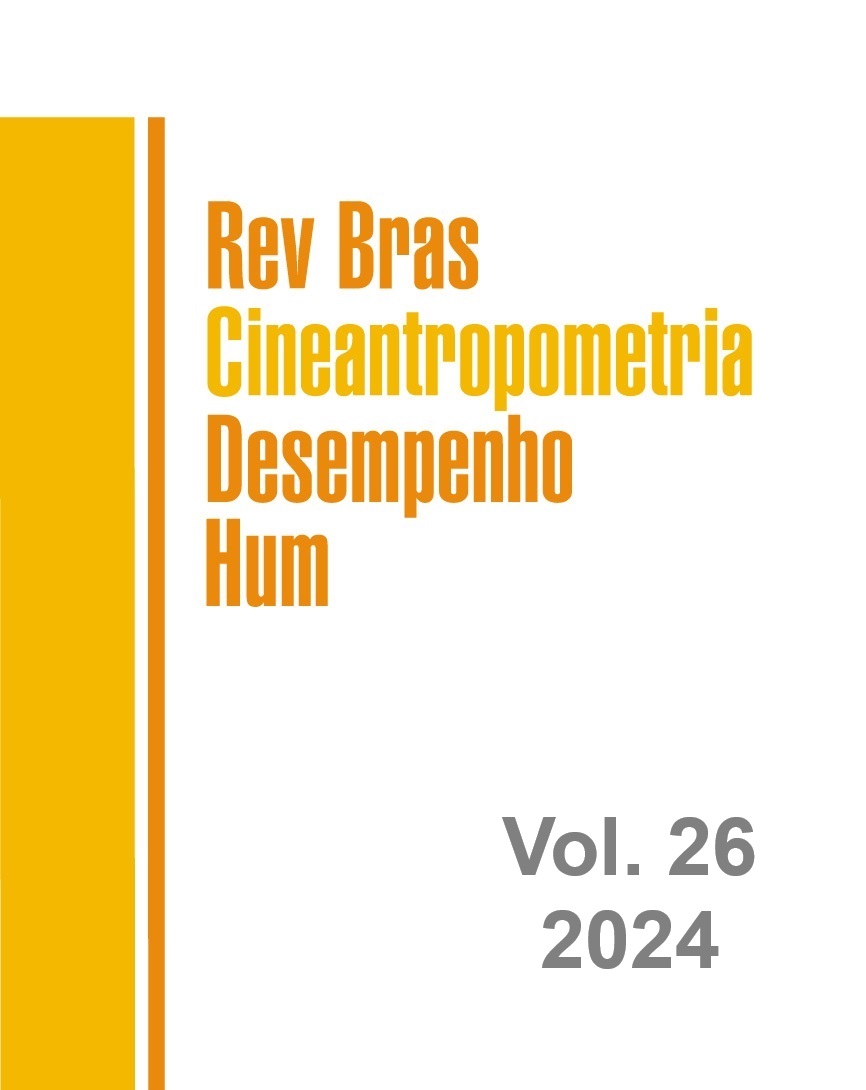Relative age effect on muscle power in Brazilian youth: a population study
DOI:
https://doi.org/10.1590/1980-0037.2024v26e98244Palabras clave:
Muscle Strength, Motor Skills, Physical fitness testing, Adolescent Sport, ChildrenResumen
This study aimed to examine the relative age effect on muscle power in a large sample of Brazilian children and adolescents. The sample consisted of 87,766 girls and boys aged 7-16 years, data collected in repeated cross-sectional surveillance carried out since 1999. The participants were grouped into four age subgroups within each chronological age based on birthdates. Upper and lower limbs muscle power were assessed using the 2-Kg medicine ball throw and horizontal jump tests, respectively. The normative distribution of physical fitness components was used for classification. The results showed a significant association between relative age and normative classification of muscle power. Among boys, there was a sequential increase in the frequency of individuals classified as "very good/excellent" as the relative age increased. A similar trend was observed among girls. The findings provided evidence of a relative age effect on muscle power in Brazilian children and adolescents. These findings have implications for the organization of structured physical activities and sports, as early-born individuals may have an advantage in performance. Further research is needed to explore the underlying mechanisms and potential interventions to mitigate the relative age effect and promote equal opportunities for all youth in physical activities and sports.
Citas
Cobley S, Baker J, Wattie N, et al. Annual age-grouping and athlete development: a meta-analytical review of relative age effects in sport. Sports Med 2009; 39: 235-256
Barnsley RH, Thompson AH, Barnsley PE. Hockey success and birthdate: the relative age effect. Canadian Association for Health. Phys Educ Recreat J 1985; 51: 23-28
Musch J, Grondin S. Unequal competition as an impediment to personal development: A review of the relative age effect in sport. Dev Rev 2001; 21: 147-167.
Helsen WF, Van Winckel J, Williams AM. The relative age effect in youth soccer across Europe. J Sports Sci 2005; 23: 629-636
Smith KL, Weir PL, Till K, et al. Relative age effects across and within female sport contexts: a systematic review and meta-analysis. Sports Med 2005; 48: 1451-1478
Delorme N, Boiché J, Raspaud M. The relative age effect in elite sport: the French case. Res Q Exerc Sport 2009; 80: 336-344
Roberts SJ, Boddy LM, Fairclough SJ, et al. The influence of relative age effects on the cardiorespiratory fitness levels of children age 9 to 10 and 11 to 12 years of age. Pediatric Exerc Sci 2012; 24: 72-83.
Sandercock GR, Taylor MJ, Voss C, et al. Quantification of the relative age effect in three indices of physical performance. J Strength Cond Res 2013; 27: 3293-3299
Veldhuizen S, Cairney J, Hay J, et al. Relative age effects in fitness testing in a general school sample: how relative are they?. J Sports Sci 2015; 33: 109-1
Nakata H, Akido M, Naruse K, et al. Relative age effect in physical fitness among elementary and junior high school students. Percep Mot Skills 2017; 124: 900-911
Drenowatz C, Ferrari G, Greier K, et al. Relative age effect in physical fitness during the elementary school years. Pediatr Rep 2021; 13: 322-333
Folgado H, Bravo J, Quintas A, et al. Relative age effect in physical fitness of South Portugal students between 10 and 18 years old. Int J Environ Res Public Health 2021; 18: 6092
Kraemer WJ, Newton, RU. Training for improved vertical jump. Sports Sci Ex 1994; 7: 1-12
Mello JB, Pinheiro EDS, Ferreira GD, et al. Relationship between Sprint, lower limb power, and change of direction speed in adolescents. Mot Rev Educ Fis 2021; 27: e1021012920
Gaya AR, Gaya ACA, Pedretti A, et al (5th ed). Brazil Sport Project, PROESP-Br: manual of measures, tests, and evaluations [available in Portuguese]. Porto Alegre: Universidade Federal do Rio Grande do Sul, 2021: 39
Gaya ACA, Guedes C, Torres L, et al. Health-related physical fitness: a pilot study on the profile of students aged 7 to 17 from the southern region of Brazil [available in Portuguese]. Rev Perfil 2002; 50-60
Bergmann GG, Araújo MLBD, Garlipp DC, et al. Annual alteration in the growth and health-related physical fitness of the school children. Rev Bras Cineantropometria & Desempenho Hum 2005; 7: 55-61
Mello JB, Pedretti A, Bergmann GG, et al. Sprint and upper limbs power field tests for the screening of low bone mineral density in children. Front Physiol 2022; 13: 1066462
Castro-Piñero J, Ortega FB, Artero EG, et al. Assessing muscular strength in youth: usefulness of standing long jump as a general index of muscular fitness. J Strength Cond Res 2010; 24: 1810-1817
Agresti A (2nd ed). Categorical data analysis. Hoboken, New York: Wiley, 2002
Malina RM. Top 10 research questions related to growth and maturation of relevance to physical activity, performance, and fitness. Res Q Exerc Sport 2014; 85: 157-173
Castagna C, Abt G, D'ottavio S, et al. Age-related effects on fitness performance in elite-level soccer referees. J Strength Cond Res 2005; 19: 785-790
Smith KL, Bélanger M, Chittle L, et al. Does relative age influence organized sport and unorganized physical activity participation in a cohort of adolescents?. Sports 2022; 10: 97
Baxter-Jones AD, Barbour-Tuck EN, Dale D, et al. The role of growth and maturation during adolescence on team-selection and short-term sports participation. Ann Hum Biol 2020; 47: 316-323
Descargas
Publicado
Número
Sección
Licencia

Direitos Autorais para artigos publicados nesta revista são do autor, com direitos de primeira publicação para a revista. Em virtude da aparecerem nesta revista de acesso público, os artigos são de uso gratuito, com atribuições próprias, em aplicações educacionais e não-comerciais, desde que seja dada a atribuição. Esta obra foi licenciada com uma Licença Creative Commons Atribuição 4.0 Internacional - CC BY


